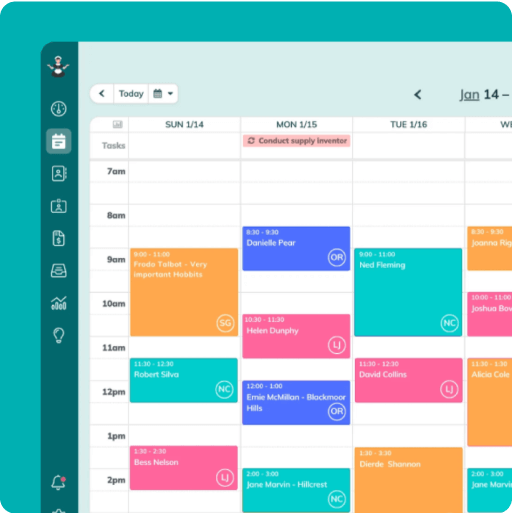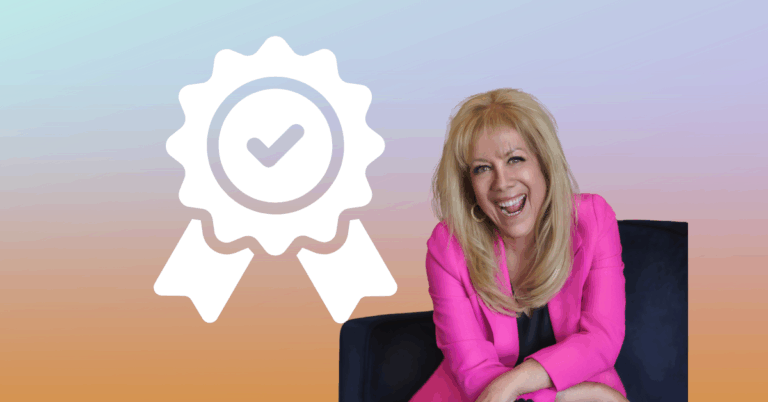By Debbie Sardone, Cleaning Business Coach and Founder of CBF

Brought to you by expert maid service owners
I’m Debbie Sardone, and I’ve spent more than 40 years in the cleaning industry helping owners build profitable, self-running businesses that give them freedom — time freedom, money freedom, people freedom, and purpose freedom.
When I started out, I was cleaning homes out of the trunk of my car. I know exactly what it feels like to work hard, stay broke, and wonder if this business will ever be worth it.
What changed everything for me was realizing I was sitting on a gold mine. I just needed to learn how to tap into it. Once I stopped undercharging and started charging premium prices with confidence, everything shifted.
Today, I run a multimillion-dollar cleaning company that’s 100% self-running, and I get to spend my time teaching other cleaning business owners how to charge premium pricing without losing the sale.
This article is adapted from my presentation at the Maid Summit, hosted by ZenMaid, and it’s for you if you’re ready to finally stop undercharging and start building a business that pays you what you’re worth.
Table of contents
The Four Freedoms That Drive Me
These are the freedoms I built my business around, and they’re the same ones I want for you:
- Time freedom — controlling your schedule without asking permission.
- Money freedom — earning enough to buy back your time.
- People freedom — working only with clients and staff who align with your values.
- Purpose freedom — doing something meaningful with your success.
For me, that purpose freedom became Cleaning for a Reason, a nonprofit that provides free cleaning for cancer patients. To date, we’ve served over 60,000 families through a network of 1,400 cleaning businesses just like yours.
All of that became possible because I learned how to charge what my service is truly worth.
The 3 Things Every Cleaning Business Needs to Charge Premium Prices
There are three pillars that make premium pricing possible:
the right mindset, the right data, and the right structure.
1. Get Your Mindset Right (Know You’re Worth More)
You have to believe you’re worth more and decide you’re going to get it.
I call this knowing your panic number, which is the amount you absolutely must charge, or it isn’t worth being in business.
Too many owners settle for “just enough.” You can’t build freedom that way.
If others are charging more, why aren’t you? Stop blaming the economy, competition, or cheap players. It’s time to start asking for what you’re worth.
2. Know Your Numbers (and Back Your Pricing with Real Data)
Guessing is not a strategy. You need facts, not fear.
I recommend a 15-minute competitive audit: a quick exercise that reveals where your rates should actually be.
How to Do It
Price shop the top-priced franchises in your area. Skip the discount players entirely. Look at the best in your market — the ones with branded cars, strong reviews, and a professional image.
Call and ask:
“What’s the cost of a four-hour prepaid gift card?”
That simple question gives you their real rate. Then confirm:
“Is that per labor hour or per team hour?”
Once you have those numbers, set your pricing at or above the highest benchmark.
There’s no advantage to being in the middle. The middle is where JCPenney and Kmart lived… and where they died.
You can either be the cheapest or the best. And I promise, you don’t want to be the cheapest.
Efficiency = Value
If you run an efficient solo model — using proven systems like Speed Cleaning — you can often charge 8–10% higher than competitors using slower team cleaning methods. Your speed and quality are part of your value.
3. Build the Structure That Supports Premium Pricing
Once you have the mindset and the data, you need the structure to support it.
Because success is in the structure.
When your business is small, you can get by winging it. But if you want to grow, you need systems for pricing, sales, and client retention.
Now, let’s walk through the framework I teach inside my CBF program, the Premium Price Playbook.
The Premium Price Playbook in Action
The Legacy Lift Framework
Most cleaning companies underprice their long-term clients. They’re loyal, but their rates haven’t kept up with inflation. That’s where my Legacy Lift Framework comes in.
1. Timing
Raise prices every 12 to 18 months.
I prefer raising on the client’s anniversary date instead of doing one mass increase in January. The smaller, individualized approach feels personal and manageable.
The only time to raise prices across the board is during a crisis, like when fuel prices spike or supply costs surge.
Pro tip: ZenMaid’s celebration feature makes it easy to automatically keep track of client anniversaries!
2. Messaging
Keep your message short, confident, and benefit-based.
Don’t over-explain or make excuses — that puts you on defense. Instead, reaffirm value.
“To ensure top-tier pay for top-tier staff and maintain your million-dollar insurance coverage, your new rate will begin next month.”
Make it about them: for example, safety, quality, consistency, not about your bills.
3. Follow-Up
Monitor your cancel rate for 30 days after a price increase.
If someone cancels, pick up the phone. Offer a win-win option like:
“We can extend a 5% discount if you prepay for the year by check.”
You save on merchant fees, and they feel like they’re getting a deal.
4. Cautions
Don’t wait years between increases. The longer you wait, the steeper the jump — and the higher the risk of losing clients.
A 3–5% increase barely registers for most customers. If it’s been years, you might go up 6–8%, even 10% at the most. Beyond that, it’s often better to let unprofitable clients go.
And never raise all at once. Do it in small batches of 5–10 clients so you can manage replacements if needed.
5. Raise New Quotes Immediately
If your market audit shows you’re underpriced, start quoting the new rates tomorrow.
Don’t wait to “catch up” your legacy clients. Every new lead should get your current market rate right away.
Attrition Break-Even Math
Want to know how many clients you can afford to lose and still break even after a price increase?
Here’s the simple rule:
The percentage you raise ≈ the percentage you can lose and still break even.
If you raise prices 4%, you can lose roughly 4 clients out of 100 and still come out even.
And remember, clients who weren’t profitable to begin with don’t count. Losing them actually makes you money.
Pro tip: Don’t raise prices on unhappy clients. Fix service issues first, then increase later. The smaller the change, the less likely they’ll act on it.
The Flip and Keep Framework: Winning at Premium Pricing
Premium pricing isn’t just about what you charge. It’s about how you sell.
That’s where my Flip and Keep Framework comes in — the three phases of a high-converting sales call.
The Three Phases of Every Sales Call
- Intro: Warm greeting, prequalify, needs assessment, gather data.
- Triage: Pivot to your value positioning script.
- Close: Quote confidently and ask for the sale.
Most owners and sales teams skip the middle phase and that’s the one that makes or breaks your price.
The Value Positioning Script
This is the “money shot.”
You must sell value before you drop the price.
If you quote first, clients have no reason to see the difference between you and the cheapest company in town.
Here’s what my “About Us” script sounds like at Buckets & Bows Maid Service:
“Buckets & Bows has been serving homes since 1984 — over four decades of experience. We’re one of the largest maid services in the country, with more than a thousand 4.9 Google reviews.
Safety and trust are at the core of our values. My husband Steve, a retired police officer, and I built this company on integrity. We never cut corners when it comes to hiring or training.
I’m also the founder of the nonprofit Cleaning for a Reason, which provides free cleanings for families battling cancer. Giving back is part of who we are.
Our cleaners are full-time, long-term employees — not temps or gig workers — which means you get the same trusted faces every time.
We back every cleaning with a 100% satisfaction guarantee and carry full insurance and bonding. And our training program is so strong that other cleaning companies come learn from us.”
That script takes about two minutes. It positions your company as experienced, safe, community-minded, and consistent — all before mentioning price.
If your sales calls last only five minutes, you’re leaving money on the table.
Winning top-dollar clients takes about 15–20 minutes of conversation. People buy from people they know, like, and trust, unless you’re the cheapest. And that’s not who we are.
Bringing It All Together
To charge premium prices without losing clients, you need three things working together:
- Mindset: Believe you’re worth more and commit to your panic number.
- Data: Price shop the top players and position yourself at or above them.
- Structure: Use a consistent cadence for raising legacy prices and a value-first script for sales calls.
Premium pricing isn’t a gamble. It’s a ground rule for running a business that pays you what you’re truly worth.
Stop apologizing for your rates. Raise them, keep them, and own them. Because greatness never goes on sale.
Quick Reference: Common Pricing Questions
How often should I raise prices?
Every 12–18 months, ideally on each client’s anniversary date.
What should I say when raising rates?
Keep it short and benefit-focused. Reaffirm value. Don’t over-explain.
When should I start charging new rates?
Immediately. All new quotes should reflect your current market rate.
What if clients say I’m too expensive?
Use your value script before price and pivot confidently in the close.
Is there any benefit to pricing in the middle?
No. There’s no advantage to being average. Be the best, not the cheapest.
Can efficiency justify higher pricing?
Absolutely. If your systems let you deliver faster and better, charge 8–10% more.
QUICK TIP FROM THE AUTHOR

Simplify and enjoy your scheduling with a scheduling software made for maid services
- Have a beautiful calendar that's full but never stressful.
- Make your cleaners happy and provide all the information they need at their fingertips.
- Convert more website visitors into leads and get new cleanings in your inbox with high-converting booking forms.
- Become part of a community of 8000+ cheering maid service owners just like you.
Start your FREE ZenMaid trial today and discover the freedom and clarity that ZenMaid can bring to your maid service! Start your FREE trial today


 Frustrated with your scheduling? Try the easiest-to-use calendar app, made by and for maid service owners.
Frustrated with your scheduling? Try the easiest-to-use calendar app, made by and for maid service owners.









